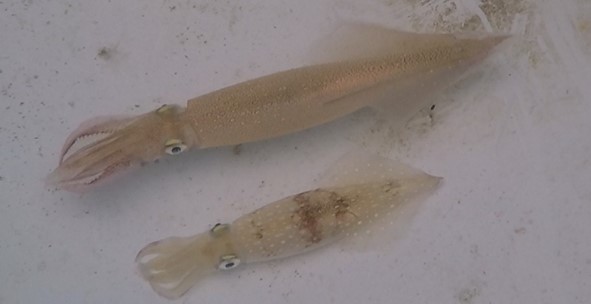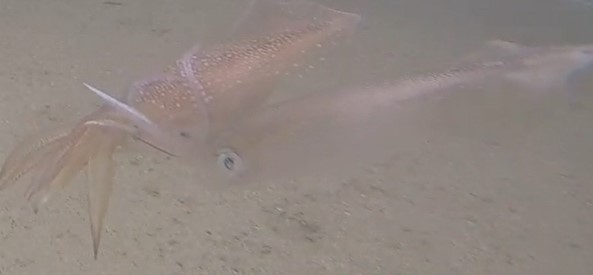Squid Hearing and Responses to Noise
Squid, and other cephalopods (e.g. cuttlefish, octopuses) can sense low-frequency sounds. Yet, compared to many vertebrate taxa, very little is known about their hearing abilities, and how human-produced sounds may affect their hearing, behavior, and ecology. Squid and other cephalopods detect sounds via paired structures, called statocysts, located in the head. The statocysts act as accelerometers, detecting acceleration of particles vibrating in an acoustic field, rather than acoustic pressure waves (which vertebrates hear). The hearing range of squid overlaps with the frequency range in which many human-made sounds dominate, such as shipping noise, seismic surveys, and sounds associated with marine construction activity. We are working to understand how marine construction sounds affect natural, ecologically important behaviors of a commercially important species of squid, Doryteuthis pealeii, found in New England waters. We also will be conducting neurophysiological studies to determine these squids’ directional sensitivity to sound.
We are specifically investigating pile driving sounds from the construction of offshore platforms, such as platforms for wind turbines. These are high-amplitude sounds that emit from structural piles driven into the seabed with high-energy hammers. Due to a rapid expansion of the offshore wind energy industry Northeast U.S. waters, where D. pealeii is most abundant, these sounds are expected to occur with increased frequency throughout the 2020s in this species’ habitat. As this species is commercially important, concern exists among fishers, governmental regulatory agencies, and the renewable energy industry of how construction activities may adversely impact these squid and other important fishery species. Further, influences of human-made sounds on squid behavior could have far-reaching ecological effects; squid are central to marine food webs, acting as prey for many top fish and mammal predators, and in turn act as predators for a wide variety of fish and invertebrate species.
We tested for squids’ behavioral responses to in-lab ‘playbacks’ of pile driving noise, in which recordings from offshore pile driving noise (during the construction of a wind farm off Rhode Island) were played through an underwater speaker to squid in tanks. These in-lab studies allow more detailed observations of behaviors in a more controlled environment, compared to field studies. By video-recording behaviors during playbacks of pile driving noise, we are investigating squids’ responses to noise in three ecologically important behavioral contexts: 1) anti-predators defense behaviors of individual squid, 2) feeding behaviors of individual squid, and 3) reproductive behaviors of groups of squid. We are quantifying variables such as the frequency of defense behaviors (e.g. inking, jetting), success rate of prey capture, and in groups of squid, time spent performing critical pre-copulatory behaviors. These analyses will allow us to determine the contexts in which marine construction noise may have stronger influence on natural behaviors squid depend on for survival and reproduction.
Key aspects toward understanding an animal’s hearing ability include how its sensitivity to sound depends on sound frequency (pitch), and on the direction of sound relative to the animal. Though frequency-dependent sensitivities to sound have been reported for a few cephalopod species, their 3D sensitivity to sound from different directions in 3D is less understood, despite the fact that the ability to sense direction of a sound is considered a fundamental characteristic of hearing. To address this knowledge gap, we are measuring the hearing abilities of squid (Doryteuthis pealeii) to sound stimuli from multiple angles and planes (e.g. vertical and horizontal). We use the ‘Auditory Evoked Potential’ method to measure electrical responses from groups of neurons near the squids’ hearing structures (statocysts). The sound stimuli are given to the squid using a ‘shaker-table’ system, which applies an acceleration stimulus (the part of an acoustic field that squid detect, rather than sound pressure waves) in different directions and 3D planes. These data will reveal whether squids will be more sensitive to sounds travelling in a horizontal plane compared to a vertical plane, and vice versa. These results will then inform how squid sensitivities and their responses to natural and human-made sounds depend on the direction these sounds travel relative to the animal.
Primary team members on this project include: Ian Jones, Jenni Stanley, and Aran Mooney. Past summer students in the Mooney Lab have also worked on this project: James Peyla, Hadley Clark, and Madison Schuum. Mooney Lab students Song and Seth Cones have also assisted with squid collection efforts. This work is funded by the Bureau of Ocean Energy Management.




